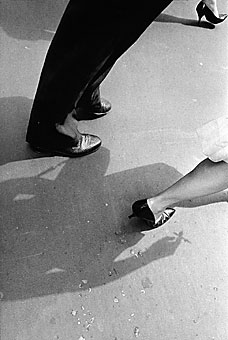 |
|
photo courtesy of CCP
|
This photograph, entitled New York by Garry Winogrand fro 1961 can be seen at the CCP's exhibit "On The Street: The New York School of Photographers."
|
|
|
By Djamila Grossman
Arizona Daily Wildcat
Thursday, January 20, 2005
Print this
For a very long time New York has symbolized the United States all around the world. Even within this country, the city embodies the American dream, but also what that dream is not.
"On The Street: The New York School of Photographers," the Center for Creative Photography's current exhibit, emphasizes structure, chaos, wealth, poverty, glamour and banalities of New York.
Photographers like Alfred Stieglitz, Ralph Steiner, Weegee, Helen Levitt, Walter Rosenblum and Sid Grossman captured the city in the early 20th Century and became known as the New York School of Photographers.
Despite some similarities, the very strong contradictions among the images dominate the exhibit. These contradictions reflect the different faces of the city, and evoke vivid impressions of how it must have felt like to walk around in it and experience it closely.
"On the Street" | | Open through Feb. 27 at the UA Center for Creative Photography |
|
The early 1920s photographs by Ralph Steiner and Alfred Stieglitz share respect and awe for technical progress. Skyscrapers, bridges and industrial structures appear huge and overwhelming compared to people in the streets, who seem small and insignificant. New symmetrical shapes dominate the image, but irregular patterns of light, dust and age set interesting accents in the works. There is a romantic aspect to those pictures, but also strong antagonism - humans seem outgrown by their own creation, which has frightening effects on the viewer.
Later works of the 1930s display humans as their main aspect. Weegee captures images most people are too scared to look at even without a camera. The dark, dirty and hidden corners of New York find their way into his lens. In order to add contrast, there is wealth and glamour next to slums and poverty. Reflections are an often used, effective way to reinforce the dubious nature of the city. The human side is emphasized by close-ups of gestures, motions and looks, and creates a very unique beauty among all people despite their differences.
The photographs expose New York in many ways. Shocking pictures not only include the numerous documents of the lower class, but also the lavish wealth of the rich. Both extremes seem to inhabit separated worlds, barely taking notice of the others' existence.
The exhibit manages to tie contrasts together and give very deep insight of New York in the 1920s and '30s. Just because the photographers did have different views on the city, their work can be combined as the New York School of Photographers.
It would have been great however, to get some more explanation in order to bring the exhibit in the context of the time and events in New York, as well as the photographers' backgrounds.
The exhibit is going to be open until Feb. 27.
